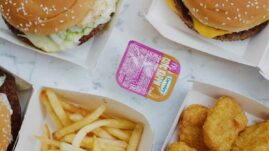Ozempic is a drug approved by the U.S. Food and Drug Administration (FDA) to treat type 2 diabetes.
It helps people better manage their blood sugar levels through improved insulin sensitivity, decreased insulin resistance, slowed digestion, and appetite suppression.
This article will explain what foods to avoid and what foods to eat when you’re taking the medication.

Key Facts
- Foods and drinks with added sugars should be avoided as they can worsen side effects and complicate blood sugar management while on Ozempic.
- Fried, spicy, and fatty foods can increase gastrointestinal upset, which is a common side effect of Ozempic. High-fat foods also pose risks to heart health, critical for people with type 2 diabetes.
- While not completely restricted, alcohol should be consumed in moderation due to its potential to cause low blood sugar levels, especially when combined with Ozempic.
- Always discuss dietary changes and symptom management with your doctor when taking Ozempic, particularly if you are experiencing severe side effects like nausea or low blood sugar.
What is Ozempic?
Ozempic, generically known as semaglutide, is a GLP-1 agonist approved in 2017 for managing type 2 diabetes via a once-weekly injectable pen. It helps improve blood sugar levels, supports weight loss, and enhances cardiovascular health.
What are the side effects?
Ozempic is associated with a range of side effects, including mild gastrointestinal effects to more severe reactions, such as thyroid tumors, pancreatitis, vision changes, kidney issues, and hypoglycemia (low blood sugar).
Serious allergic reactions are also possible. Immediate medical attention should be sought if symptoms like fever, vision changes, or significant pain occur.
For people who cannot tolerate Ozempic, alternative treatments are available.
What foods should I avoid while using Ozempic?
While no specific foods are strictly off-limits when taking Ozempic, certain foods can worsen side effects and complicate blood sugar management. Here are some types of foods to consider avoiding:
Foods and drinks with added sugar
Eating items like soda, ice cream, candy, chocolates, and other sweets can spike your blood sugar levels and negatively impact your A1c (a measure of glucose control over the previous 2 to 3 months).
Because managing blood sugar is crucial for people with diabetes, it’s wise to steer clear of added sugars to help with weight management and improve overall health.
Fried, greasy, and fatty foods
Foods high in fat, and especially fast food, can induce bloating, nausea, constipation, and gas. The effects of these foods may be more pronounced while on Ozempic. People with diabetes are at higher risk for heart disease, and avoiding trans fats and overly greasy foods is also beneficial for heart health.
Spicy foods
Spicy foods can cause gastrointestinal upset and worsen acid reflux. Because Ozempic delays stomach emptying, it can exacerbate these issues.
Alcohol
Moderate consumption of alcohol isn’t prohibited with Ozempic, but caution is advised. Both Ozempic and alcohol can increase the risk of hypoglycemia.
The Dietary Guidelines for Americans 2020-2025 suggest no more than two drinks per day for men and one for women, though abstaining is healthiest. Consult your healthcare provider if you’re concerned about alcohol and diabetes management.
See more in: Ozempic and Alcohol: Can You Drink While Taking Ozempic?
Refined carbohydrates
While they might seem like a safer choice compared to sugary foods, refined carbohydrates like white bread, white rice, crackers, and certain cereals quickly convert to glucose in the body. This can challenge your ability to manage blood sugar effectively.
These foods also generally lack fiber, which helps manage blood sugar levels, so it’s best to avoid them if you’re using Ozempic.
Each person’s reaction to foods can vary, so it’s essential to monitor your body’s response and discuss any dietary concerns with your healthcare provider.
What foods should I eat while using Ozempic?
Wondering what you can eat while taking Ozempic? There are plenty of healthy options available! The key is to focus on whole, unprocessed foods without added sugars. Here’s what to include in your diet:
Low-glycemic vegetables
Enjoy plenty of low-carb vegetables like broccoli, cauliflower, kale, spinach, bell peppers, tomatoes, cucumbers, onions, green beans, and lettuce. These vegetables don’t cause blood sugar spikes and can improve insulin sensitivity.
That said, they are high in fiber, so if you’re not accustomed to a fiber-rich diet, you might initially experience bloating and gas and need to incorporate these foods into your meal plan slowly.
Low-glycemic fruits
Opt for fruits like coconut, avocado, blackberries, strawberries, blueberries, raspberries, grapefruit, cherries, and oranges. These fruits raise blood sugar more slowly than higher-glycemic alternatives and are packed with essential vitamins, minerals, and fiber — making them a great substitute for sugary desserts.
Lean proteins
Include lean proteins, such as eggs, low-fat cheese, Greek yogurt, chicken, turkey, fish, nuts, tofu, and beans in your meals. These proteins are not only nutritious but typically require minimal to no insulin adjustments. Choose grilling or steaming over frying to avoid unhealthy fats and added carbohydrates.
Whole grains
Incorporate whole grains like whole-grain bread, whole-grain pasta, and brown rice into your diet. These foods are higher in carbs but are rich in fiber, which moderates their blood sugar impact, making them suitable for people with diabetes. Whole grains may also support heart health.
No-sugar beverages
Stay hydrated with plenty of water and other healthy beverages like coffee and tea, avoiding added sugars or creamy, fatty additives.
By choosing the foods outlined above, you can maintain stable blood sugar levels and support your overall health while on Ozempic.
A note on Ozempic and coffee
There is currently no evidence to suggest that coffee can improve or lessen the side effects of the medicine.
However, since both Ozempic and coffee can irritate the gastrointestinal tract in some people, some experts recommend sticking with a modest amount of coffee, such as 1 or 2 cups per day. (The FDA defines moderate coffee intake as 400 milligrams of caffeine a day, equating to about 4 or 5 cups.)
What foods can help me manage nausea while taking Ozempic?
If you’re experiencing severe nausea and vomiting while on Ozempic, it’s important to consult your healthcare provider, who may adjust your dosage. If you are able to eat, the following dietary tips may help alleviate nausea:
- Eat more slowly: Taking time to eat can help reduce nausea.
- Opt for smaller, more frequent meals: Smaller portions eaten more frequently throughout the day can ease nausea.
- Choose bland foods: Foods like soups, whole-grain crackers, oatmeal, toast, and rice are gentle on the stomach.
- Avoid high-fat and high-sugar foods: Foods and drinks high in fats and sugars can exacerbate nausea.
- Stay hydrated with clear liquids: Drinking clear liquids such as water, broth, or herbal teas can help maintain hydration and reduce discomfort.
These strategies can help manage nausea effectively while your body adjusts to the medicine.
How do you get the best results while using Ozempic?
Ozempic is a strong prescription medication that has helped many people manage their diabetes effectively. To maximize its benefits, it’s crucial to pair the medicine with a healthy diet and regular physical activity.
You might begin to see improvements in your blood sugar levels within just a few weeks of starting the treatment. Maintaining a consistent routine of balanced eating and exercise can enhance the effectiveness of Ozempic as part of your overall diabetes management plan.
Did you find this article helpful? Click Yes or No below to let us know!





